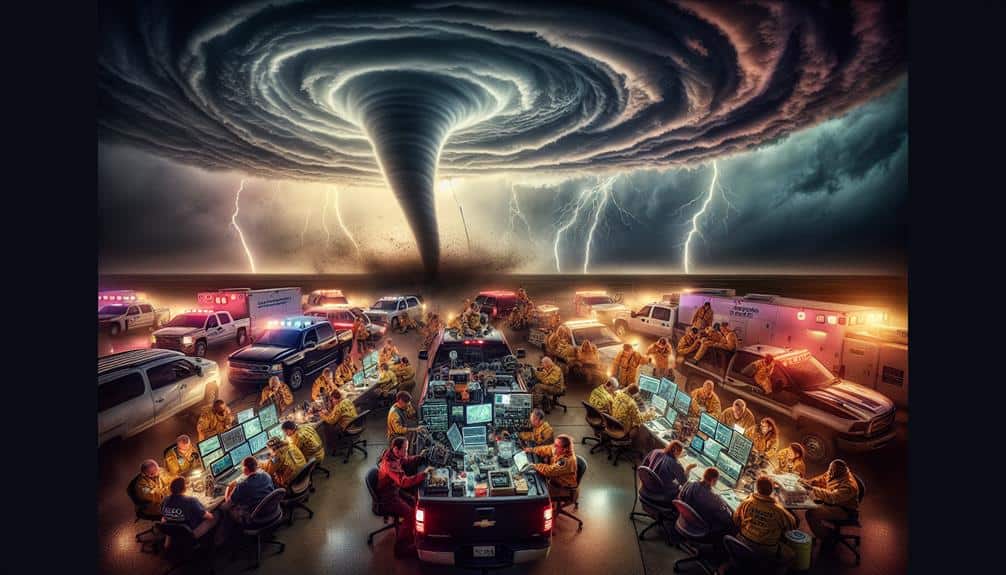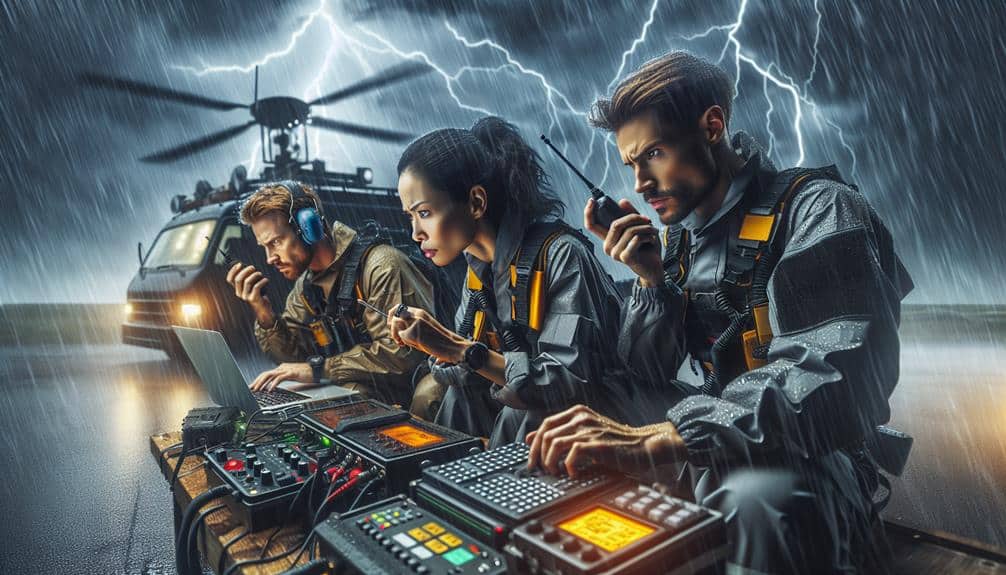In our quest to build robust emergency response strategies, we rely on three essential simulation exercises: tabletop drills, full-scale exercises, and virtual simulations. Tabletop drills let us simulate emergency scenarios in a controlled setting, guaranteeing we assess and refine our response strategies. Full-scale exercises push our coordination skills under realistic, high-pressure situations, testing the full extent of our emergency response capabilities. Virtual simulations leverage advanced technology to provide interactive, flexible training sessions with detailed performance analytics. By combining these exercises, we secure our preparedness for any situation. To uncover the depth of each method's impact on response readiness, stay with us.
Key Points
- Tabletop drills simulate emergency scenarios, assessing team response strategies and coordination in a controlled environment.
- Full-scale exercises immerse teams in realistic, high-pressure scenarios to thoroughly test emergency response capabilities.
- Virtual simulations provide interactive, flexible training sessions to enhance decision-making under pressure without logistical challenges.
- Combining different simulation exercises ensures comprehensive preparedness for varied emergency situations.
Tabletop Drills
Tabletop drills serve as an important tool for us to simulate emergency scenarios and assess our response strategies in a controlled environment. Through scenario development, we can tailor these drills to reflect potential incidents that might affect our community. By doing so, we guarantee that our team is prepared for a variety of situations, adapting quickly and efficiently.
During the incident simulation, we gather key personnel to walk through each phase of the emergency response. This includes identifying threats, allocating resources, and implementing evacuation or containment procedures. Each step is meticulously examined to highlight strengths and pinpoint areas needing improvement.
After the drill, we conduct a team debriefing to discuss the outcomes and gather feedback. This critical phase allows us to evaluate our response and make necessary adjustments to our emergency plans. The debriefing session fosters open communication and collective problem-solving, empowering us to enhance our preparedness.
Response evaluation is central to these drills. By critically analyzing our actions and decisions, we can refine our strategies and guarantee that we're ready for real-world emergencies. Tabletop drills provide a foundation for effective, coordinated responses, ultimately granting us the freedom to act decisively and confidently when crises arise.
Full-Scale Exercises
Full-scale exercises immerse our team in realistic, high-pressure scenarios to test our emergency response capabilities thoroughly. These exercises are the epitome of practical applications where we confront real-time scenarios that challenge our coordination skills and team dynamics. By simulating actual emergencies, we can see how our strategies hold up under pressure and identify areas for improvement.
In these exercises, we face several coordination challenges, such as:
- Communication Breakdowns: Testing our ability to maintain clear and effective communication despite chaotic conditions.
- Resource Management: Ensuring that we allocate and utilize our resources efficiently during a crisis.
- Role Clarity: Confirming that everyone understands their responsibilities to avoid overlaps or gaps in our response.
- Incident Command System: Practicing the implementation of the Incident Command System to streamline decision-making and coordination.
These full-scale exercises offer invaluable insights into our team's readiness and adaptability. We get a real-time look at how our team dynamics operate under stress, and we can fine-tune our approach to handle different emergencies more effectively.
It's about preparing for the unexpected and ensuring that when a real crisis hits, we're not just ready—we're confident and capable.
Virtual Simulations
Virtual simulations offer a cutting-edge approach to honing our emergency response skills without the logistical challenges of physical drills. We can leverage online training platforms to create interactive scenarios that test our decision-making under pressure. These simulations immerse us in realistic environments where every choice has consequences, allowing us to refine our strategies in real-time.
One major advantage is the flexibility virtual simulations provide. We don't need to gather everyone in one location, which means more frequent and accessible training sessions. This adaptability is a game-changer, especially for organizations with remote teams or limited resources.
Interactive scenarios are the heart of effective virtual simulations. These scenarios can be tailored to specific emergency situations—ranging from natural disasters to cyber-attacks. By engaging with these detailed, lifelike challenges, we can identify weaknesses in our current plans and make data-driven improvements.
Moreover, virtual simulations offer robust analytics. Post-simulation reports give us insights into our performance, highlighting areas for improvement. This data-centric approach guarantees that our emergency response protocols are continuously evolving.
In essence, virtual simulations empower us to train smarter, not harder. By embracing this innovative method, we can enhance our readiness and guarantee we're prepared for any crisis.
Frequently Asked Questions
How Do You Measure the Effectiveness of an Emergency Response Simulation Exercise?
We measure the effectiveness of an emergency response simulation exercise by using evaluation methods and performance metrics. We assess response time, coordination efficiency, and decision-making accuracy to guarantee our teams are prepared for real-world emergencies.
What Are the Key Elements of a Successful After-Action Review?
In a successful after-action review, we focus on lessons learned and improvement strategies. We identify what went well, what didn't, and develop actionable steps for future improvement, ensuring our team is better prepared and more effective.
How Often Should Emergency Response Simulations Be Conducted?
Imagine a hospital's annual disaster drill saving lives. We should conduct simulations quarterly to guarantee readiness. The frequency of simulations and timing of drills are essential for maintaining our team's agility and effectiveness in emergencies.
What Are Common Challenges Faced During Emergency Response Simulations?
During emergency response simulations, we often face challenges like team coordination issues and communication breakdowns. These obstacles can hinder our effectiveness, but identifying and addressing them during drills helps us improve our real-world response capabilities.
How Can Community Members Be Involved in Simulation Exercises?
We can boost community involvement by organizing town hall meetings, creating volunteer opportunities, and offering training workshops. These engagement strategies guarantee everyone's prepared, informed, and ready to act, fostering a resilient and self-reliant community.


